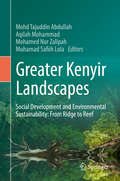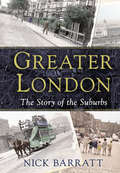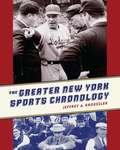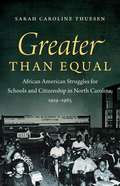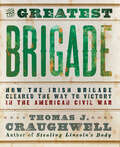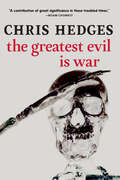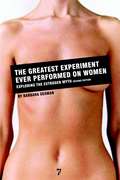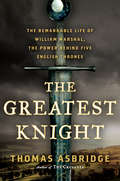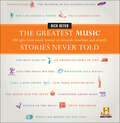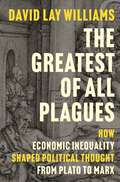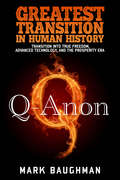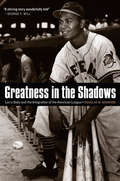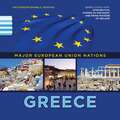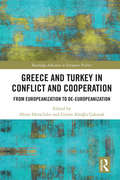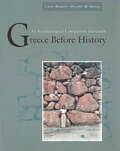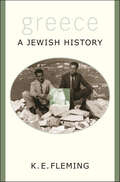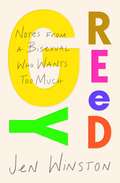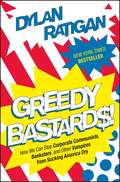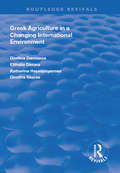- Table View
- List View
Greater Kenyir Landscapes: Social Development and Environmental Sustainability: From Ridge to Reef
by Mohd Tajuddin Abdullah Aqilah Mohammad Mohamed Nor Zalipah Muhamad Safiih LolaThis book contains research findings from three major study areas, natural sciences, social sciences, and public policy and management. The focus area extends over geographical zones ranging from mountainous area of Mount Gagau in the Taman Negara National Park, down to the coastal islands of Bidong, Redang and Perhentian on the eastern coast of Peninsular Malaysia. Chapters on natural sciences examine the physicochemical characteristics of water, physiological and ecological constraints to geological and climatological aspects. The social science and management chapters observe the rich ethno-heritage of local communities and how they interact and develop as a culture, and public policy for sustainable management. Viewpoints from political science, history, sociology, economics, anthropology and management science are also taken into account. This book is intended for researchers and graduate students to create an understanding of the rich heritage, while policy makers plan for future generations. Readers will benefit from this book by studying the gaps in the current knowledge and move to develop further research to understand the unexplored forest canopies and the dynamics of the changing Greater Kenyir landscapes.
Greater London: The Story of the Suburbs
by Nick BarrattLondon's suburbs may stretch for well over 600 square miles, but in historical accounts of the capital they tend to take something of a back seat. In Greater London, historian Nick Barratt places them firmly centre stage, tracing their journey from hamlets and villages far out in the open countryside to fully fledged urban enclaves, simultaneously demonstrating the crucial role they have played in the creation of today's metropolis.Starting in the first century AD, he shows how the tiny settlements that grew up in the Thames Valley gradually developed, and how they were shaped by their proximity to the city. He describes the spread of the first suburbs beyond the city walls, and traces the ebb and flow of population as people moved in to find jobs or away to escape London's noise and bustle. He charts the transformation wrought by the coming of the railways, the fight to preserve Hampstead Heath, Epping Forest and other green spaces and the struggle to create a London-wide form of government. He gives an account of wartime destruction and peacetime reconstruction, and then brings the story to the present with a description of the very varied nature of today's suburbs and their inhabitants. In the process, he evokes Tudor Hackney and Georgian Hampton, explains why Victorian Battersea and Finchley were so different from one another, and follows Islington's fall from grace and subsequent recovery.Magnificently illustrated throughout with contemporary engravings and photographs, this is the essential history for anyone who has ever lived in London.
The Greater New York Sports Chronology
by Kroessler Jeffrey A.Jeffrey A. Kroessler's comprehensive and entertaining time line stretches from the pastoral entertainments of the Dutch to the corporate captivity of professional sports. He chronicles events ranging from the truly heroic to the heartbreaking, from moments of municipal greatness to inescapable social change. Through it all he plants the world of sport at the very center of New York's story. Fully illustrated, The Greater New York Sports Chronologycovers the spectacle of blood sports like bullbaiting to the birth of baseball, the now-forgotten six-day pedestrian contests, and today's New York City Marathon. Alongside great moments like the Mets' "amazin'" World Series win in 1969, Joe Louis's historic bouts with Max Schmeling, Jackie Robinson's breaking of baseball's color line, and Secretariat's remarkable Triple Crown win at Belmont, we encounter the point-shaving scandals of college basketball and the corrupting influence of organized crime in professional boxing. Beyond immortals like Lou Gehrig and Joe Namath, we also find such once well known figures as Joe Lapchick, Marty Glickman, Gertrude Ederle, and Toots Shor. Year by year, this chronology recounts chess matches, America's Cup races, dog shows, golf tournaments, polo matches, tennis games, and more. Kroessler describes the historic venues, boxing arenas, gyms, stadiums, ballparks, and racetracks that have come and gone, yet made New York the undisputed capital of American sport. Witnessing it all, of course, are the greatest fans in the world.
The Greater New York Sports Chronology
by Jeffrey KroesslerJeffrey A. Kroessler's comprehensive and entertaining time line stretches from the pastoral entertainments of the Dutch to the corporate captivity of professional sports. He chronicles events ranging from the truly heroic to the heartbreaking, from moments of municipal greatness to inescapable social change. Through it all he plants the world of sport at the very center of New York's story.Fully illustrated, The Greater New York Sports Chronology covers the spectacle of blood sports like bullbaiting to the birth of baseball, the now-forgotten six-day pedestrian contests, and today's New York City Marathon. Alongside great moments like the Mets' "amazin'" World Series win in 1969, Joe Louis's historic bouts with Max Schmeling, Jackie Robinson's breaking of baseball's color line, and Secretariat's remarkable Triple Crown win at Belmont, we encounter the point-shaving scandals of college basketball and the corrupting influence of organized crime in professional boxing. Beyond immortals like Lou Gehrig and Joe Namath, we also find such once well known figures as Joe Lapchick, Marty Glickman, Gertrude Ederle, and Toots Shor. Year by year, this chronology recounts chess matches, America's Cup races, dog shows, golf tournaments, polo matches, tennis games, and more. Kroessler describes the historic venues, boxing arenas, gyms, stadiums, ballparks, and racetracks that have come and gone, yet made New York the undisputed capital of American sport. Witnessing it all, of course, are the greatest fans in the world.
Greater Portland: Urban Life and Landscape in the Pacific Northwest
by Carl AbbottSelected by Choice magazine as an Outstanding Academic Title for 2001<P><P> It has been called one of the nation's most livable regions, ranked among the best managed cities in America, hailed as a top spot to work, and favored as a great place to do business, enjoy the arts, pursue outdoor recreation, and make one's home. Indeed, years of cooperative urban planning between developers and those interested in ecology and habitability have transformed Portland from a provincial western city into an exemplary American metropolis. Its thriving downtown, its strong neighborhoods, and its pioneering efforts at local management have brought a steady procession of journalists, scholars, and civic leaders to investigate the "Portland style" that values dialogue and consensus, treats politics as a civic duty, and assumes that it is possible to work toward public good.Probing behind the press clippings, acclaimed urban historian Carl Abbott examines the character of contemporary Portland--its people, politics, and public life--and the region's history and geography in order to discover how Portland has achieved its reputation as one of the most progressive and livable cities in the United States and to determine whether typical pressures of urban growth are pushing Portland back toward the national norm.In Greater Portland, Abbott argues that the city cannot be understood without reference to its place. Its rivers, hills, and broader regional setting have shaped the economy and the cityscape. Portlanders are Oregonians, Northwesteners, Cascadians; they value their city as much for where it is as for what it is, and this powerful sense of place nurtures a distinctive civic culture. Tracing the ways in which Portlanders have talked and thought about their city, Abbott reveals the tensions between their diverse visions of the future and plans for development.Most citizens of Portland desire a balance between continuity and change, one that supports urban progress but actively monitors its effects on the region's expansive green space and on the community's culture. This strong civic participation in city planning and politics is what gives greater Portland its unique character, a positive setting for class integration, neighborhood revitalization, and civic values. The result, Abbott confirms, is a region whose unique initiatives remain a model of American urban planning.
Greater than Equal
by Sarah Caroline ThuesenDuring the half century preceding widespread school integration, black North Carolinians engaged in a dramatic struggle for equal educational opportunity as segregated schooling flourished. Drawing on archival records and oral histories, Sarah Thuesen gives voice to students, parents, teachers, school officials, and civic leaders to reconstruct this high-stakes drama. She explores how African Americans pressed for equality in curricula, higher education, teacher salaries, and school facilities; how white officials co-opted equalization as a means of forestalling integration; and, finally, how black activism for equality evolved into a fight for something "greater than equal--integrated schools that served as models of civic inclusion. These battles persisted into the Brown era, mobilized black communities, narrowed material disparities, fostered black school pride, and profoundly shaped the eventual movement for desegregation. Thuesen emphasizes that the remarkable achievements of this activism should not obscure the inherent limitations of a fight for equality in a segregated society. In fact, these unresolved struggles are emblematic of fault lines that developed across the South, and serve as an urgent reminder of the inextricable connections between educational equality, racial diversity, and the achievement of first-class citizenship.
The Greatest Brigade: How the Irish Brigade Cleared the Way to Victory in the American Civil War
by Thomas J. CraughwellA history of the impressive, predominantly Irish American brigade of the Union Army and their role in its victory over the Confederacy.Faugh a Ballagh! Clear the Way!This is the story of a band of heroes that covered the Yankee retreat at Bull Run, drove the Confederates from the Sunken Road at Antietam, and made charge after charge up Marye’s Heights at Fredericksburg. The gallantry of the Irish Brigade won them the admiration of the high command of both North and South, earned them seven Medals of Honor, and after the war, went a long way to helping the Irish assimilate into the American mainstream.Shouting their Gaelic battle cry, the men of the Irish Brigade charged across the bloodiest battlefields of the Civil War and into the realm of legend. The Greatest Brigade is a grand narrative history of these Irishmen who fought in every major battle in the Eastern Theater of the Civil War, including Bull Run, Antietam, Fredericksburg, Gettysburg, the Wilderness, and Appomattox.Praise for The Greatest Brigade“An exciting journey through the major battles of the Civil War alongside the members of the famed Irish Brigade. Well researched, compellingly written, filled with fascinating illustrations, and with a story that holds the reader with a “bulldog grip,” Thomas Craughwell has written a regimental history that deserves to be on every Civil War lover’s bookshelf.” —Jason Emerson, author of The Madness of Mary Lincoln and Lincoln the Inventor“This engrossing book will appeal both to Civil War buffs and to those interested in the Irish American experience.” —Library Journal“A paean to the Irish immigrants who fought for their adopted homeland. . . . This spirited hagiography marches through the battles fought by the Army of the Potomac’s justly renowned Irish Brigade at quickstep pace. Each chapter reads like an episode of a History Channel documentary.” —Historynet
The Greatest Evil is War
by Chris HedgesAn unflinching indictment of the horror and obscenity of war by one of our finest war correspondents.Drawn from experience and interviews by Pulitzer-prize-winner Chris Hedges, this book looks at the hidden costs of war, what it does to individuals, families, communities and nations.In fifteen short chapters, Chris Hedges astonishes us with his clear and cogent argument against war, not on philosophical grounds or through moral arguments, but in an irrefutable stream of personal encounters with the victims of war, from veterans and parents to gravely wounded American serviceman who served in the Iraq War, to survivors of the Holocaust, to soldiers in the Falklands War, among others. Hedges reported from Sarajevo, and was in the Balkans to witness the collapse of the Soviet Union. In 2002 he published War Is a Force that Gives Us Meaning, which the Los Angeles Times described as &“the best kind of war journalism… bitterly poetic and ruthlessly philosophical&” and the New York Times called &“a brilliant, thoughtful, timely, and unsettling book.&” In the twenty years since, Hedges has not wanted to write another book on the subject of war—until now, with the outbreak of war in Ukraine. It is important again to be reminded who are the victors of the spoils of war and of other unerring truths, not only in this war but in all modern wars, where civilians are always the main victims, and the tools and methods of war are capable of so much destruction it boggles the mind. This book is an unflinching indictment of the horror and obscenity of war by one of our finest war correspondents.
The Greatest Experiment Ever Performed on Women: Exploding the Estrogen Myth
by Barbara SeamanWith the ardent tone of a close friend, Barbara Seaman draws on forty years of journalistic research to expose the "menopause industry" and shows how estrogen therapy often causes more problems--including breast cancer, heart attack, and stroke--than it cures. The Greatest Experiment Ever Performed on Women tracks the well-intentioned discovery of synthetic estrogen through the unconscionable and misleading promotion of a dangerous drug.
The Greatest Knight
by Thomas Asbridge<P>A thrillingly intimate portrait of one of history's most illustrious knights--William Marshal--that vividly evokes the grandeur and barbarity of the Middle Ages <P>William Marshal was the true Lancelot of his era--a peerless warrior and paragon of chivalry--yet over the centuries, the spectacular story of his achievements passed from memory. Marshal became just one more name in the dusty annals of history. Then, in 1861, a young French scholar named Paul Meyer made a startling discovery during an auction of rare medieval manuscripts. Meyer stumbled upon the sole surviving copy of an unknown text--the first contemporary biography of a medieval knight, later dubbed the History of William Marshal. This richly detailed work helped to resurrect Marshal's reputation, putting flesh onto the bones of this otherwise obscure figure, yet even today William Marshal remains largely forgotten. <P>As a five-year-old boy, Marshal was sentenced to execution and led to the gallows, but this landless younger son survived his brush with death and went on to train as a knight. Against all odds, Marshal rose through the ranks--serving at the right hand of five English monarchs--to become a celebrated tournament champion, a baron and politician and, ultimately, a regent of the realm. <P>William Marshal befriended the great figures of his day, from Richard the Lionheart and Eleanor of Aquitaine to the infamous King John, and helped to negotiate the terms of Magna Carta--the first "bill of rights." By the age of seventy, the once-forsaken child had been transformed into the most powerful man in England, yet he was forced to fight in the front line of one final battle, striving to save the kingdom from a French invasion in 1217. <P>In The Greatest Knight, renowned historian Thomas Asbridge draws upon the thirteenth-century biography and an array of other contemporary evidence to present a compelling account of William Marshal's life and times. Asbridge follows Marshal on his journey from rural England onto the battlefields of France, to the desert castles of the Holy Land and the verdant shores of Ireland, charting the unparalleled rise to prominence of a man bound to a code of honor, yet driven by unquenchable ambition. <P>This knight's tale lays bare the brutish realities of medieval warfare and the machinations of the royal court, and draws us into the heart of a formative period of our history, when the West emerged from the Dark Ages and stood on the brink of modernity. It is the story of one remarkable man, the birth of the knightly class to which he belonged and the forging of the English nation. <P><b>A New York Times Bestseller</b>
The Greatest Music Stories Never Told: 100 Tales from Music History to Astonish, Bewilder, and Stupefy (The\greatest Stories Never Told Ser.)
by Rick BeyerThis collection of little-known stories from music history is “an effortless summer read for the music lover” (Houston Chronicle).The author of the highly successful History Channel series The Greatest Stories Never Told returns with new historic tales, this time focusing on amazing music stories that aren’t taught in the average classroomRick Beyer plums the vast archives of the History Channel to deliver a treasure trove of obscure and fascinating stories to delight and entertain. The Greatest Music Stories Never Told continues the series tradition with short, fascinating tales accompanied by an array of stunning and diverse photographs from around the globe.The Greatest Music Stories Never Told illuminates the origins of a fascinating range of music topics, from instruments and styles to composers and technological advances—all which show us how little we really know. Guaranteed to astonish, bewilder, and stupefy, this all new volume will appeal not only to history buffs but to pop culture audiences and music fans of all ages and stripes.“We picked up the book expecting to inflate our egos, reinforcing the myth that we know everything there is to know about music history. Short answer--we were wrong, very wrong.” —LA Weekly“A little book you won’t be able to put down.” —Florida Times-Union “History like you’ve never read it before . . . Amusing.” —The Tennessean“Lively, offbeat and surprising.” —Denver Rocky Mountain News“Fascinating.” —Dallas Morning News“Full of tasty morsels . . . A delightful book to arm one for the next dull cocktail party.” —Chicago Tribune
The Greatest of All Plagues: How Economic Inequality Shaped Political Thought from Plato to Marx
by David Lay WilliamsHow the great political thinkers have persistently warned against the dangers of economic inequalityEconomic inequality is one of the most daunting challenges of our time, with public debate often turning to questions of whether it is an inevitable outcome of economic systems and what, if anything, can be done about it. But why, exactly, should inequality worry us? The Greatest of All Plagues demonstrates that this underlying question has been a central preoccupation of some of the most eminent political thinkers of the Western intellectual tradition.David Lay Williams shares bold new perspectives on the writings and ideas of Plato, Jesus, Thomas Hobbes, Jean-Jacques Rousseau, Adam Smith, John Stuart Mill, and Karl Marx. He shows how they describe economic inequality as a source of political instability and a corrupter of character and soul, and how they view unchecked inequality as a threat to their most cherished values, such as justice, faith, civic harmony, peace, democracy, and freedom. Williams draws invaluable insights into the societal problems generated by what Plato called &“the greatest of all plagues,&” and examines the solutions employed through the centuries.An eye-opening work of intellectual history, The Greatest of All Plagues recovers a forgotten past for some of the most timeless books in the Western canon, revealing how economic inequality has been a paramount problem throughout the history of political thought.
The Greatest Transition In Human History: Transition into True Freedom, Advanced Technology, and The Prosperity Era
by Mark BaughmanKnowledge is power. Real truth is freedom. Freedom is what our Founding Fathers wanted to create as the beacon of light to the world in 1776. America was to be the example of what humanity could be. Was that really achieved? The Greatest Transition in Human History tells the real story of America over the past over 200 years - the heartbreak, false-flag wars, hidden technology, power, corruption, and manipulation. Does the American citizen have real Freedom as the great Constitution and Bill of Rights intended? The Greatest Transition in Human History is the real emotion story of great Americans and patriots standing up for these great rights. These freedoms were taken for granted by so many - for many fell asleep and did not participate as much as we should have, including myself for many years. No more, for I work for humanity, and freedom. I want that real Freedom Bell to ring for all. For in the oath to a military person sworn in to our armed forces, they are to fight any enemy both foreign and domestic. The Greatest Transition in Human History is the story of brave people standing up for individual freedoms and rights worldwide, in the Greatest Secret War ever.
Greatness in the Shadows: Larry Doby and the Integration of the American League
by Douglas M. BransonJust weeks after Jackie Robinson joined the Brooklyn Dodgers, Larry Doby joined Robinson in breaking the color barrier in the major leagues when he became the first black player to integrate the American League, signing with the Cleveland Indians in July 1947. Doby went on to be a seven-time All-Star center fielder who led the Indians to two pennants. In many respects Robinson and Doby were equals in their baseball talent and experiences and had remarkably similar playing careers: both were well-educated, well-spoken World War II veterans and both had played spectacularly, albeit briefly, in the Negro Leagues. Like Robinson, Doby suffered brickbats, knock-down pitches, spit in his face, and other forms of abuse and discrimination. Doby was also a pioneering manager, becoming the second black manager after Frank Robinson. Well into the 1950s Doby was the only African American All-Star in the American League during a period in which fifteen black players became National League All-Stars. Why is Doby largely forgotten as a central figure in baseball’s integration? Why has he not been accorded his rightful place in baseball history? Greatness in the Shadows attempts to answer these questions, bringing Doby’s story to life and sharing his achievements and firsts with a new generation.
The Grecanici of Southern Italy: Governance, Violence, and Minority Politics
by Stavroula PipyrouThe Grecanici are a Greek linguistic minority in the Calabria region of Italy, remnants of a population that has resided there since late antiquity. Their language represents a holdover from the Middle Ages, at least, and possibly even to the Greek colonies of the classical period. For decades the Grecanici passionately fought to be recognized by the Italian state as an official linguistic minority, finally achieving this goal in 1999. Violence, corruption, and mismanagement are inextricable parts of the social fabric, but Grecanici have crafted the means to invert hegemonic culture and participate in the power games of minority politics.The Grecanici of Southern Italy provides a comprehensive ethnography that examines the ways the minority developed and sustain enduring cultural forms of solidarity and relatedness. Stavroula Pipyrou proposes the concept of "fearless governance" to describe overlapping and sometimes contradictory systems of power, authority, and relational networks that enable the Grecanici to achieve political representation at the intersection of local, national, and global encounters. Refuting easy assumptions of top-down governmental influence, Pipyrou shows how the Grecanici find political representation through the European Union and UNESCO, state policy, civic associations, family networks and illegal organizations; not being afraid to take risks, incur wrath, lose friends, or risk death in challenging the political status-quo.
Greece (Major European Union Nations)
by Kim EtingoffGreece's economy has struggled a lot in recent years, but it has a long, rich history to draw on to help solve its problems. Greece is known as the birthplace of democracy and the Olympics, among many other things. It has been a member of the EU since 1981. Today, the EU and Greece are working together to help solve this country's serious economic problems. Discover more about this exciting, modern nation!
Greece and Turkey in Conflict and Cooperation: From Europeanization to De-Europeanization (Routledge Advances in European Politics)
by Alexis Heraclides Gizem Alio 287 Lu ÇakmakThis book offers a sober, contemplative and comprehensive coverage of Greek–Turkish relations, covering in depth the current political climate, with due regard to the historical dimension. The book includes up-to-date accounts of the traditional areas of unresolved discord (Aegean, minorities, Cyprus, the Patriarchate), with emphasis on why they remain contentious, despite the thaw in Greek–Turkish relations from 1999 until recently. It also covers new topics and challenges that have led to cooperation as well as friction, such as unprecedented economic cooperation, energy resources, or the refugee crisis. Furthermore, the volume deals with the ‘Europeanization’ of Greek–Turkish relations and other facilitating factors as they appeared in the first decade of the 21st century (including the role of civil society) as well as the contrary, ‘de-Europeanization’ from the 2010 onwards, which presages a hazardous downward trend in their relations, often not helped by the media in both countries, which is also examined. This volume will be essential reading to scholars and students of Greek–Turkish relations, more generally Greece and Turkey, and more broadly to the study of South European Politics, European Union politics, security studies and International Relations.
Greece Before History: An Archaeological Companion and Guide
by Priscilla Murray Curtis RunnelsThis book, a guide and companion to the prehistoric archaeology of Greece, is designed for students, travelers, and all general readers interested in archaeology. Greece has perhaps the longest and richest archaeological record in Europe, and this book reviews what is known of Greece from the earliest inhabitants in the Stone Age to the end of the Bronze Age and the collapse of the Minoan and Mycenaean civilizations. The book describes the prehistoric cultures of Greece in chronological order, and illustrates with 98 detailed drawings each culture's typical artifacts, architecture, burial customs, and art. Written in an informal and accessible style free of scientific jargon, the book can be used in the classroom or as a guide for the traveler, or read simply for pleasure by anyone with a curiosity about the earliest ages of this fascinating region. Although intended for a wide audience, the book has a solid scientific foundation. The authors are professional archaeologists with more than 25 years of experience in the field and with a first-hand knowledge of the methods and results of contemporary research. There is no other book today that covers the same range of periods and subjects, making it essential reading for anyone interested in the early civilizations that shaped the Greek landscape, laid the foundations for Classical Greek civilization, and contributed in many ways to the formation of the modern Greek world. The authors have been careful to address the many questions concerning prehistoric Greece that have been asked them by students and visitors to Greece through the years. The illustrations were created especially for this book, showing familiar artifacts and sites from a new perspective, and selecting others for illustration that rarely, if ever, appear in popular publications.
Greece: A Jewish History
by K. E. FlemingK. E. Fleming's Greece--a Jewish History is the first comprehensive English-language history of Greek Jews, and the only history that includes material on their diaspora in Israel and the United States. The book tells the story of a people who for the most part no longer exist and whose identity is a paradox in that it wasn't fully formed until after most Greek Jews had emigrated or been deported and killed by the Nazis. For centuries, Jews lived in areas that are now part of Greece. But Greek Jews as a nationalized group existed in substantial number only for a few short decades--from the Balkan Wars (1912-13) until the Holocaust, in which more than 80 percent were killed. Greece--a Jewish History describes their diverse histories and the processes that worked to make them emerge as a Greek collective. It also follows Jews as they left Greece--as deportees to Auschwitz or émigrés to Palestine/Israel and New York's Lower East Side. In such foreign settings their Greekness was emphasized as it never was in Greece, where Orthodox Christianity traditionally defines national identity and anti-Semitism remains common.
Greedy: Notes from a Bisexual Who Wants Too Much
by Jen WinstonNamed one of the Best Books of 2021 by Oprah Daily, Glamour, Shondaland, BuzzFeed, and more! A hilarious and whip-smart collection of essays, offering an intimate look at bisexuality, gender, and, of course, sex. Perfect for fans of Lindy West, Samantha Irby, and Rebecca Solnit—and anyone who wants, and deserves, to be seen. If Jen Winston knows one thing for sure, it&’s that she&’s bisexual. Or wait—maybe she isn&’t? Actually, she definitely is. Unless…she&’s not? Jen&’s provocative, laugh-out-loud debut takes us inside her journey of self-discovery, leading us through stories of a childhood &“girl crush,&” an onerous quest to have a threesome, and an enduring fear of being bad at sex. Greedy follows Jen&’s attempts to make sense of herself as she explores the role of the male gaze, what it means to be &“queer enough,&” and how to overcome bi stereotypes when you&’re the posterchild for all of them: greedy, slutty, and constantly confused. With her clever voice and clear-eyed insight, Jen draws on personal experiences with sexism and biphobia to understand how we all can and must do better. She sheds light on the reasons women, queer people, and other marginalized groups tend to make ourselves smaller, provoking the question: What would happen if we suddenly stopped? Greedy shows us that being bisexual is about so much more than who you&’re sleeping with—it&’s about finding stability in a state of flux and defining yourself on your own terms. This book inspires us to rethink the world as we know it, reminding us that Greedy was a superpower all along.
Greedy Bastards
by Dylan RatiganThe host of the eponymous MSNBC show, Dylan Ratigan offers a bold and original post-partisan program to resuscitate the American Dream. At a time of deep concern with the state of America's economy and government, it seems that all the media can give us is talking (or screaming) heads who revel in partisan brinkmanship. Then there's Dylan Ratigan--an award-winning journalist respected and admired across the political spectrum. In Greedy Bastards, he rips the lid off of our deeply crooked system--and offers a way out.Employing the nuanced reporting and critical analysis that have earned him so much respect, Ratigan describes the five "vampires" that are sucking the nation dry, including an educational system that values mediocrity above all else; a healthcare system that is among the priciest and least-effective infrastructures in the industrialized world; a political system in which lobbyists write legislation; a "master-slave" relationship with our Chinese bankers; and an addiction to foreign oil that has sapped our willingness to innovate. In offering solutions to these formidable and entrenched obstacles, he does nothing less than lay the groundwork for a political movement dedicated to tackling the rot at the heart of the country. In its desperation, America needs more than just endless stock tips and Wall Street navel-gazing. It needs passionate debate and smart policy--and a hero to take on the establishment. Dylan Ratigan is that hero, and this is the book that will rally people behind him. make it right.
Greek Agriculture in a Changing International Environment (Routledge Revivals)
by Dimitris Damianos Efthalia Dimara Katharina Hassapoyannes Dimitris SkurasPublished in 1998, the aim of this text is to promote awareness of the evolution of Greek agriculture, as well as of the development of national strategies, in conformity with the Common Agricultural Policy provision - which is important for a successful confrontation of modern and prospective international challenges. It offers a case study developing integrated policies for unemployment, for prevention of diversification of rural areas and for provision of solutions to the problem of increasing competition, while enhancing environmental quality and making rational use of productive resources.
Greek Americans: Struggle and Success
by Charles C. MoskosThis is an engrossing account of Greek Americans--their history, strengths, conflicts, aspirations, and contributions. This is the story of immigrants, their children and grandchildren, most of whom maintain an attachment to Greek ethnic identity even as they have become one of this country's most successful ethnic groups.
Greek Art And Archaeology
by Richard T. NeerThis is the text that sets a new standard in its field with striking visuals, fascinating reconstructions, accessible prose, and coverage of the wider Greek world. The Second Edition extends student understanding of Greek art in history through richer archaeological context and expanded coverage of both the earliest Bronze Age and latest Hellenistic periods.
